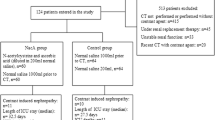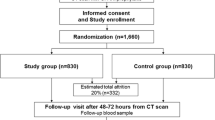Abstract
Background
The occurrence of contrast-induced acute kidney injury (CIAKI) has paralleled the increased number of diagnostic interventions requiring radiographic contrast media (CM). Several strategies aimed at preventing renal injury following iodine have been carried out over the last several years. The aim of this study was to evaluate the impact of three different strategies aimed at preventing CIAKI in patients with renal dysfunction (serum creatinine >1.25 mg/dl or estimated creatinine clearance <45 ml/min) receiving low osmolar CM for diagnostic–therapeutic procedures.
Methods
Candidates received 154 mmol NaHCO3 solution (B0) at a rate of 3 ml/kg/h from at least 2 h before the procedure and at 1 ml/kg/h during and for the next 6–12 h; the same schedule plus N-acethyl-cysteine (NAC) 600 mg twice daily the day before and the day of the procedure (BN) or NAC as above plus 154 mmol NaCl solution at a rate of 3 ml/kg/h from at least 2 h before the procedure and at 1 ml/kg/h during and for the next 6–12 h (SN). Serum creatinine (SCr) was measured at baseline and on days 2 or occasionally 3 after CM. The main outcome measure was the occurrence of CIAKI, defined as a ≥25 % increase in SCr within 2–3 days of CM.
Results
The three groups were similar with regard to age, gender distribution, weight, baseline serum levels of creatinine, sodium, potassium, urate and estimated creatinine clearance. A larger proportion of individuals received ACEIs/ARAs in the BN group (p < 0.05), but in the SN group, more patients declared a past history of acute myocardial infarction or had high blood pressure, and few displayed mild–moderate left ventricular dysfunction (p < 0.05). CIAKI occurred in 24/123 (19.5 %) assessable patients (15/42 in the B0 group, 3/43 in the BN group and 6/38 in the SN group; p < 0.01). Thus, 15/42 patients who did not receive NAC developed CIAKI in contrast to 9/81 who did (p < 0.01). Multivariate logistic regression models showed that the use of NAC was the unique factor associated with a statistically significant influence for the occurrence of CIAKI (OR: 0.18; 95 % CI: 0.04–0.72; p = 0.016).
Conclusions
The results from this study show that: (1) the occurrence of CIAKI after low-osmolar CM administration is similar to that reported worldwide. (2) NAC-based renoprotective measures are superior for the prevention of CIAKI in patients with previous renal dysfunction. (3) They also demonstrate that bicarbonate expansion alone has limited value in preventing CIAKI. For those individuals at risk, combination prophylaxis including volume expansion plus NAC should be recommended to reduce the chance of overt kidney injury following CM administration.


Similar content being viewed by others
References
Briguori C, Tavano D, Colombo A. Contrast agent-associated nephrotoxicity. Prog Cardiovasc Dis. 2003;45:493–503.
McCullough PA, Wolyn R, Rocher LL, Levin RN, O′Neill WW. Acute renal failure after coronary intervention: incidence, risk factors, and relationship to mortality. Am J Med. 1997;103:368–75.
Castini D, Lucreziotti S, Bosotti L, et al. Prevention of contrast-induced nephropathy: a single center randomized study. Clin Cardiol. 2010;33(3):63–8.
Wong GTC, Irwin MG. Contrast-induced nephropathy. Br J Anaesth. 2007;99(4):474–83.
Goldenberg I, Matetzky S. Nephropathy induced by contrast media: pathogenesis, risk factors and preventive strategies. CMAJ. 2005;172(11):1461–71.
Parfrey PS, Griffiths SM, Barrett BJ, et al. Contrast material-induced renal failure in patients with diabetes mellitus, renal insufficiency, or both. A prospective controlled study. N Engl J Med. 1989;320:143–9.
Aspelin P, Aubry P, Fransson SG, Strasser R, Willenbrock R, Berg KJ. Nephrotoxic effects in high-risk patients undergoing angiography. N Engl J Med. 2003;348(6):491–9.
Kuhn MJ, Chen N, Sahani DV, et al. The PREDICT Study: a randomized double-blind comparison of contrast-induced nephropathy after low or isoosmolar contrast agent exposure. AJR. 2008;191:151–7.
Marenzi G, Marana I, Lauri G, et al. The prevention of radiocontrast-agent-induced nephropathy by hemofiltration. N Engl J Med. 2003;349:1333–40.
Baker CSR, Baker LRI. Prevention of contrast nephropathy after cardiac catheterization. Heart. 2001;85:361–2.
Solomon R, Werner C, Mann D, D’Elia J, Silva P. Effects of saline, mannitol, and furosemide to prevent acute decreases in renal function induced by radiocontrast agents. N Engl J Med. 1994;331(21):1416–20.
Rudnick MR, Goldfarb S, Wexler L, et al. Nephrotoxicity of ionic and nonionic contrast media in 1196 patients: a randomized trial. Kidney Int. 1995;47(1):254–61.
Stone GE, McCullough PA, W for the CONTRAST Investigators. Fenoldopam mesylate for the prevention of contrast-induced nephropathy: a randomized controlled trial. JAMA. 2003;290(17):2284–91.
Bakris GL, Lass NA, Glock D. Renal hemodynamics in radiocontrast medium-induced renal dysfunction: a role for dopamine-1 receptors. Kidney Int. 1999;56:206–10.
Bakris G, Burnett J. A role for calcium in radiocontrast induced reductions in renal hemodynamics. Kidney Int. 1985;27(2):465–8.
Kapoor A, Kumar S, Gulati S, Gambhir S, Sethi R, Sinha N. The role of theophylline in contrast-induced nephropathy: a case–control study. Nephrol Dial Transpl. 2002;17(11):1936–41.
Huber W, Ilgmann K, Page M, et al. Effect of theophylline on contrast material–induced nephropathy in patients with chronic renal insufficiency: controlled randomized, double-blinded study. Radiology. 2002;223:772–9.
Safirstein R, Andrade L, Vieira JM. N-acetylcysteine and nephrotoxic effects of RC agents: a new use for an old drug. N Engl J Med. 2000;343:210–2.
Teruel JL, Maracen R, Herrero JA, Ortuno FJ. An easy and effective procedure to prevent radiocontrast nephrotoxicity in high-risk patients [letter]. Nephron. 1989;51(2):282.
Kelly AM, Dwamena B, Cronin P, Bernstein SJ, Carlos RC. Meta-analysis: effectiveness of drugs for preventing contrast-induced nephropathy. Ann Int Med. 2008;148:284–94.
Heyman SN, Rosen S, Brezis M. Radiocontrast nephropathy: a paradigm for the synergism between toxic and hypoxic insults in the kidney. Exp Nephrol. 1994;2:153–7.
Heyman SN, Brezis M, Epstein FH, Spokes K, Silva P, Rosen S. Early renal medullary hypoxic injury from radiocontrast and indomethacin. Kidney Int. 1991;40:632–42.
Heyman SN, Brezis M, Reubinoff CA, et al. Acute renal failure with selective medullary injury in the rat. J Clin Invest. 1988;82:401–12.
Brezis M, Rosen S. Hypoxia of the renal medulla—its implications for disease. N Engl J Med. 1995;332(10):647–55.
Rudnick MR, Berns JS, Cohen RM, Goldfarb S. Contrast media-associated nephrotoxicity. Semin Nephrol. 1997;17(1):15–26.
Pflueger A, Larson TS, Nath KA, King BF, Gross JM, Knox FG. Role of adenosine in contrast media-induced acute renal failure in diabetes mellitus. Mayo Clin Proc. 2000;75:1275–83.
Bakris GL, Lass N, Gaber AO, Jones J, Burnett J Jr. Radiocontrast medium-induced declines in renal function: a role for oxygen free radicals. Am J Physiol. 1990;258:F115–20.
Bakris GL, Gabaer AO, Jones JD. Oxygen free radical involvement in urinary Tamm-Horsfall protein excretion after intrarenal injection of contrast medium. Radiology. 1990;175:57–60.
Katholi R, Woods T Jr, Taylor G, et al. Oxygen free radicals and contrast nephropathy. Am J Kidney Dis. 1998;32(1):64–71.
Lee HC, Sheu SH, Yen HW, Lai WT, Chang JG. JNK/ATF2 pathway is involved in iodinated contrast media-induced apoptosis. Am J Nephrol. 2010;31:125–33.
Tepel M, Van der Giet M, Schwarzfeld C, Laufer U, Liermann D, Zidek W. Prevention of radiographic-contrast-agent-induced reductions in renal function by N-acetylcysteine. N Engl J Med. 2000;343(3):180–4.
Skyu KG, Cheng JJ, Kuan P. N-acetylcysteine protects against acute renal damage in patients with abnormal renal function undergoing a coronary procedure. J Am Coll Cardiol. 2002;40:1383–8.
Kay J, Chow WH, Chan TM, et al. N-acetylcysteine for prevention of acute deterioration of renal function following elective coronary angiography and intervention: a randomized controlled trial. JAMA. 2003;289(5):553–8.
Baker CS, Wragg A, Kuman S, De Palma R, Baker L, Knight C. A rapid protocol for the prevention of contrast-induced renal dysfunction: the RAPPID study. J Am Coll Cardiol. 2003;41(12):2114–8.
Birck R, Krzossk S, Markowetz F, et al. Acetylcysteine for prevention of contrast nephropathy: meta-analysis. Lancet. 2003;362:598–603.
Spargias K, Alexopoulos E, Kyrzopoulos S, et al. Ascorbic acid prevents contrast-mediated nephropathy in patients with renal dysfunction undergoing coronary angiography or intervention. Circulation. 2004;110(18):2837–42.
Alpern RJ. Renal acidification mechanisms. In: Brenner BM, editor. The kidney. 6th ed. Philadelphia, PA: WB Saunders; 2000. p. 455–519.
Halliwell B, Gutteridge JMC. Role of free radicals and catalytic metal ions in human diseases: an overview. Methods Enzymol. 1990;186:1–85.
Cohen G. The Fenton reaction. In: Greenwald RA, editor. CRC handbook of methods for oxygen radical research. Boca Raton, FL: CRC Press Inc; 1985. p. 55–64.
Merten GJ, Burgess WP, Gray LV, et al. Prevention of contrast-induced nephropathy with sodium bicarbonate. A randomized controlled trial. JAMA. 2004;291(19):2328–34.
Gomes VO, Poli de Figueredo CE, Caramori P, et al. N-acethylcysteine does not prevent contrast induced nephropathy after cardiac catheterization with an ionic low osmolality contrast medium: a multicenter clinical trial. Heart. 2005;91:774–8.
Nash K, Hafeez A, Hou S. Hospital-acquired renal insufficiency. Am J Kidney Dis. 2002;39:930–6.
McCullough PA, Adam A, Becker CR, et al. Epidemiology and prognostic implications of contrast-induced nephropathy. Am J Med. 2006; 98 Suppl 6A:5K–13K.
Mehran R, Aymong ED, Nikolsky E, et al. A simple risk score for prediction of contrast-induced nephropathy after percutaneous coronary intervention: development and initial validation. J Am Coll Cardiol. 2004;44(7):1393–9.
Goldenberg I, Shechter M, Matetzky S, et al. Oral acethylcysteine as an adjunct to saline hydration for the prevention of contrast-induced nephropathy following coronary angiography. A randomized controlled trial and review of the current literature. Eur Heart J. 2004;25:212–8.
Maioli M, Toso A, Leoncini M, et al. Sodium bicarbonate versus saline for the prevention of contrast-induced nephropathy in patients with renal dysfunction undergoing coronary angiography or intervention. J Am Coll Cardiol. 2008;52:599–604.
Navaneethan SD, Singh S, Appasamy S, Wing RE, Sehgai AR. Sodium bicarbonate therapy for the prevention of contrast-induced nephropathy: a systematic review and meta-analysis. Am J Kidney Dis. 2009;53(4):617–27.
Liu R, Nair D, Ix J, Moore DH, Bent S. N-acethylcysteine for the prevention of contrast-induced nephropathy. A systematic review and meta-analysis. J Gen Intern Med. 2005;20:193–200.
Marenzi G, Assanelli E, Marana I. N-acethylcysteine and contrast-induced nephropathy in primary angioplasty. N Engl J Med. 2006;354:2773–82.
Calvin AD, Misra S, Pflueger A. Contrast-induced acute kidney injury and diabetic nephropathy. Nat Rev Nephrol. 2010;6(11):679–88.
ACT Investigators. Acethylcysteine for prevention of renal outcomes in patients undergoing coronary and peripheral vascular angiography. Main results from the randomized acethylcysteine for contrast-induced nephropathy trial (ACT). Circulation. 2011;124:1250–9.
Kunadian V, Zaman A, Spyridopoulos I, Qiu W. Sodium bicarbonate for the prevention of contrast induced nephropathy: a meta-analysis of published clinical trials. Eur J Radiol. 2010; doi:10.1016/j.ejrad.2009.12.015.
Novikov M, Molitoris B, Campos S, et al. Renoprotective properties of acetazolamide in a rat model of contrast media induced renal failure (abstract). J Am Soc Nephrol. 2003;14:345A.
Hoste EA, De Waele JJ, Gevaert SA, Uchino S, Kellum JA. Sodium bicarbonate for prevention of contrast-induced acute kidney injury: a systematic review and meta-analysis. Nephrol Dial Transpl. 2010;25(3):747–58.
Zoungas S, Nimomiya T, Huxley R, et al. Systematic review: sodium bicarbonate treatment regimens for the prevention of contrast-induced nephropathy. Ann Int Med. 2009;11(9):631–8.
From AM, Bartholmai BJ, Williams AW, Cha SS, Pfluger A, McDonald FS. Sodium bicarbonate is associated with an increased incidence of contrast nephropathy. A retrospective cohort study of 7977 patients at Mayo Clinic. Clin J Am Soc Nephrol. 2008;3(1):10–8.
Richardson DE, Regino CA, Yao H, Johnson JV. Methionineoxidation by hydrogen peroxymonocarbonate, a reactive oxygen species formed from CO2/bicarbonate and hydrogen peroxide. Free Radic Biol Med. 2003;35(12):1538–50.
Mishra J, Ma Q, Prada A, et al. Identification of neutrophil gelatinase-associated lipocalin as a novel early urinary biomarker for ischemic renal injury. J Am Soc Nephrol. 2003;14(10):2534–43.
Haase M, Bellomo R, Decarajan P, Schlattmann P, Haase-Fielitz A, the NGAL Meta-Analysis Investigator Group. Accuracy of neutrophil gelatinase-associated lipocalin (NGAL) in diagnosis and prognosis in acute kidney injury: a systematic review and meta-analysis. Am J Kidney Dis. 2009;54(6):1012–24.
Soni S, Ronco C, Katz N, Cruz D. Early diagnosis of acute kidney injury: the promise of novel biomarkers. Blood Purify. 2009;28:165–74.
Acknowledgments
We are grateful and indebted to Claudio D. Gonzalez, MD, for the critical reading of this manuscript.
Conflict of interest
None.
Author information
Authors and Affiliations
Corresponding author
About this article
Cite this article
Heguilén, R.M., Liste, A.A., Payaslian, M. et al. N-acethyl-cysteine reduces the occurrence of contrast-induced acute kidney injury in patients with renal dysfunction: a single-center randomized controlled trial. Clin Exp Nephrol 17, 396–404 (2013). https://doi.org/10.1007/s10157-012-0722-3
Received:
Accepted:
Published:
Issue Date:
DOI: https://doi.org/10.1007/s10157-012-0722-3




